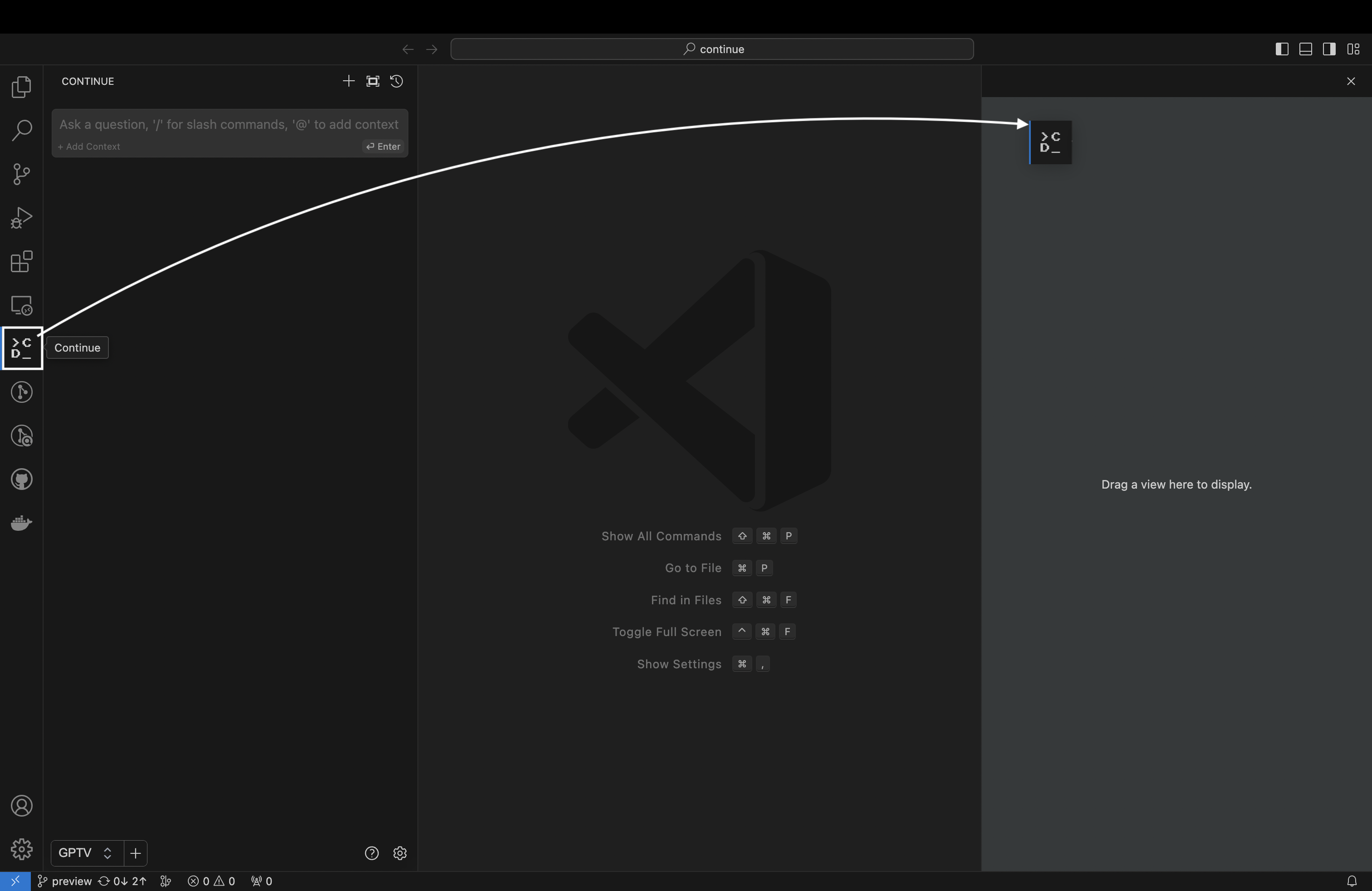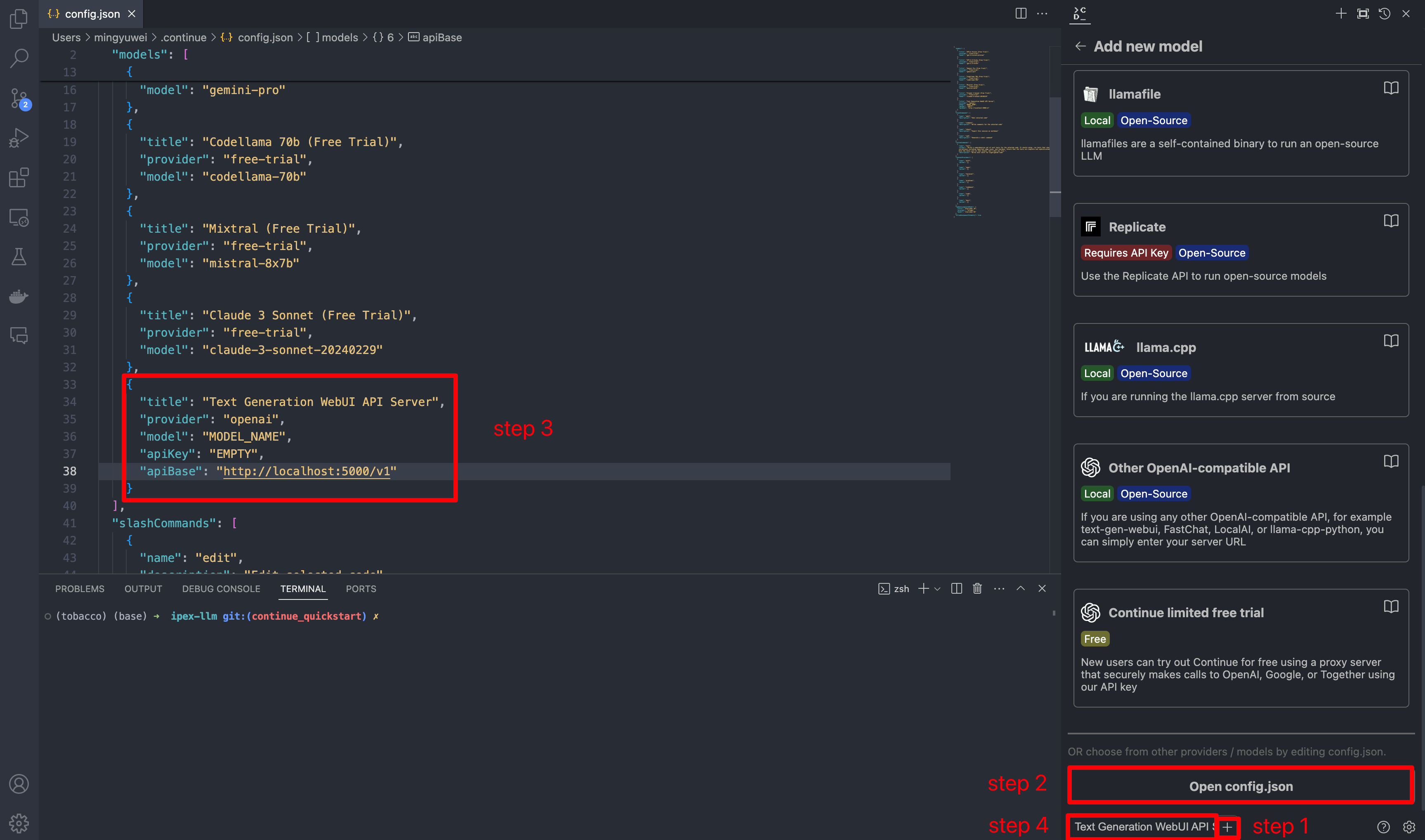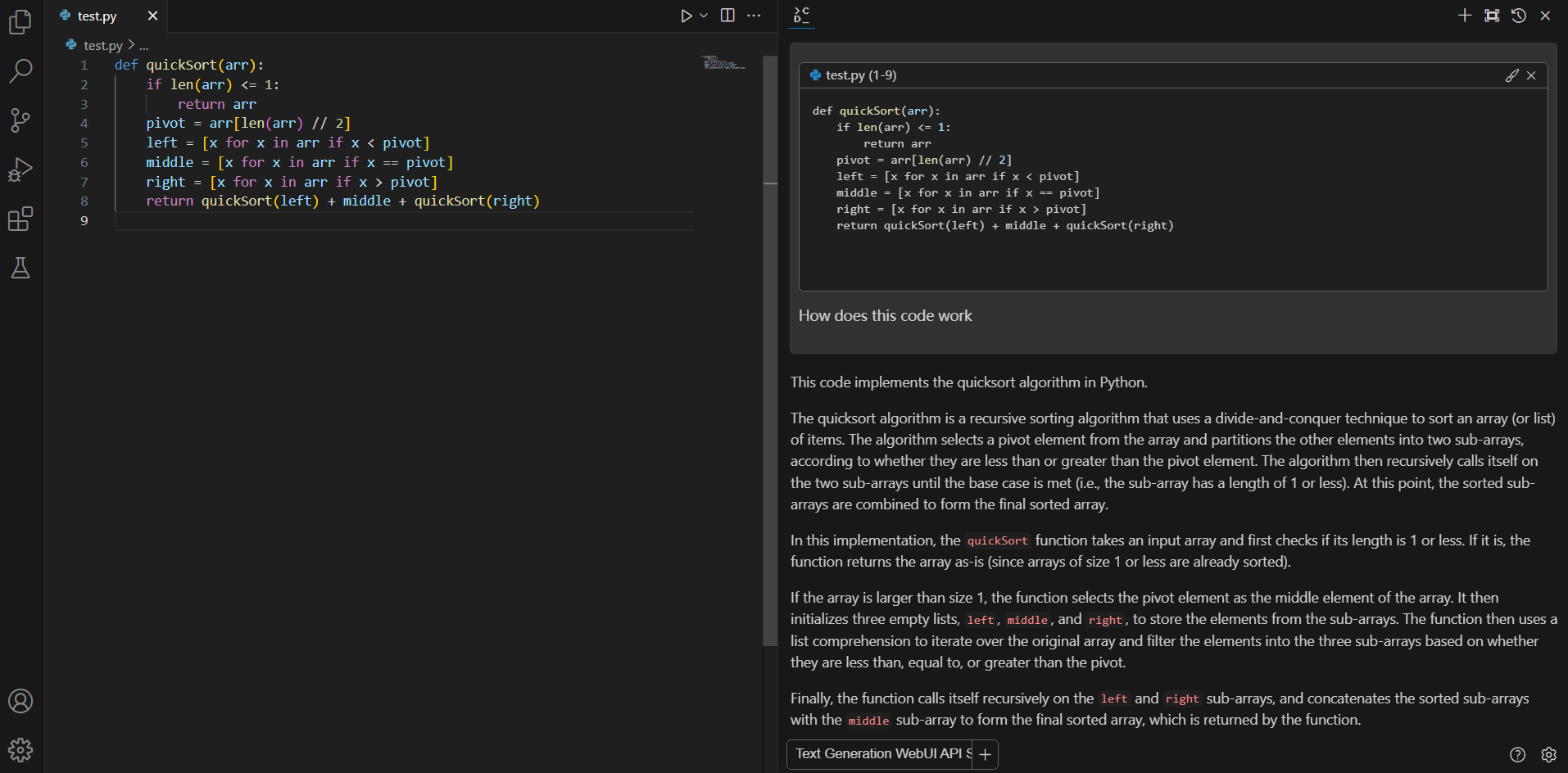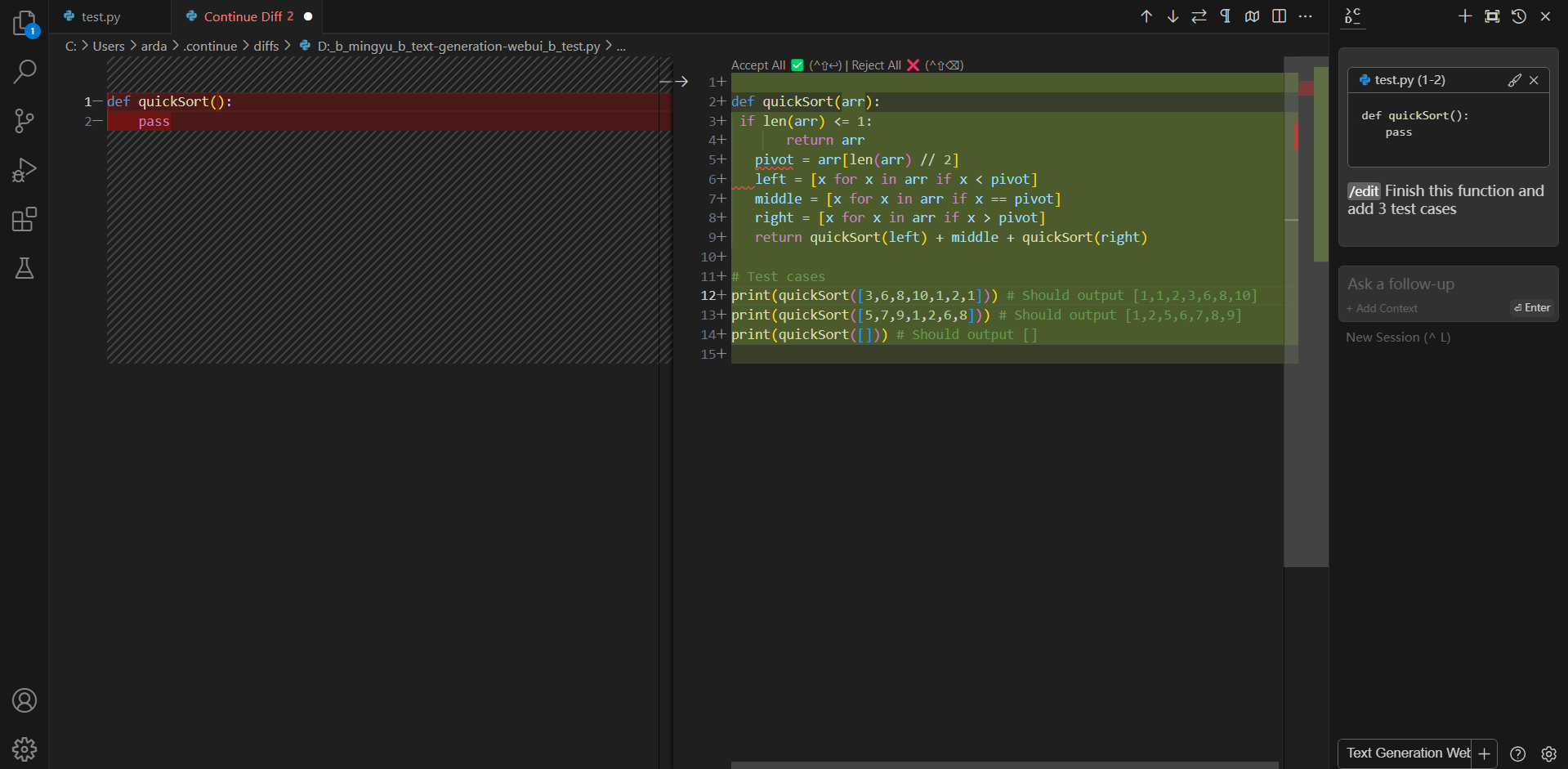# Run Coding Copilot in VSCode with Intel GPU
[**Continue**](https://marketplace.visualstudio.com/items?itemName=Continue.continue) is a coding copilot extension in [Microsoft Visual Studio Code](https://code.visualstudio.com/); by porting it to [`ipex-llm`](https://github.com/intel-analytics/ipex-llm), users can now easily leverage local LLMs running on Intel GPU (e.g., local PC with iGPU, discrete GPU such as Arc, Flex and Max) for code explanation, code generation/completion, etc.
See the demos of using Continue with [Mistral-7B-Instruct-v0.1](https://huggingface.co/mistralai/Mistral-7B-Instruct-v0.1) running on Intel A770 GPU below.
| Code Generation |
Code Explanation |
|
|
## Quickstart
This guide walks you through setting up and running **Continue** within _Visual Studio Code_, empowered by local large language models served via [Ollama](./ollama_quickstart.html) with `ipex-llm` optimizations.
### 1. Install and Run Ollama Serve
Visit [Run Ollama with IPEX-LLM on Intel GPU](./ollama_quickstart.html), and follow the steps 1) [Install IPEX-LLM for Ollama](./ollama_quickstart.html#install-ipex-llm-for-ollama), 2) [Initialize Ollama](./ollama_quickstart.html#initialize-ollama) and 3) [Run Ollama Serve](./ollama_quickstart.html#run-ollama-serve) to install and initialize and start the Ollama Service.
```eval_rst
.. important::
Please make sure you have set ``OLLAMA_HOST=0.0.0.0`` before starting the Ollama service, so that connections from all IP addresses can be accepted.
.. tip::
If your local LLM is running on Intel Arc™ A-Series Graphics with Linux OS, it is recommended to additionaly set the following environment variable for optimal performance before the Ollama service is started:
.. code-block:: bash
export SYCL_PI_LEVEL_ZERO_USE_IMMEDIATE_COMMANDLISTS=1
```
### 2. Prepare and Run Model
#### Pull [`codeqwen:latest`](https://ollama.com/library/codeqwen)
In a new terminal window:
```eval_rst
.. tabs::
.. tab:: Linux
.. code-block:: bash
export no_proxy=localhost,127.0.0.1
./ollama pull codeqwen:latest
.. tab:: Windows
Please run the following command in Anaconda Prompt.
.. code-block:: cmd
set no_proxy=localhost,127.0.0.1
ollama pull codeqwen:latest
.. seealso::
Here's a list of models that can be used for coding copilot on local PC:
- Code Llama:
- WizardCoder
- Mistral
- StarCoder
- DeepSeek Coder
You could find them in the `Ollama model library `_ and have a try.
```
#### Create and Run Model
First, create a `Modelfile` file with contents:
```
FROM codeqwen:latest
PARAMETER num_ctx 4096
```
then:
```eval_rst
.. tabs::
.. tab:: Linux
.. code-block:: bash
./ollama create codeqwen:latest-continue -f Modelfile
.. tab:: Windows
Please run the following command in Anaconda Prompt.
.. code-block:: cmd
ollama create codeqwen:latest-continue -f Modelfile
```
You can now find `codeqwen:latest-continue` in `ollama list`.
Finially, run the `codeqwen:latest-continue`:
```eval_rst
.. tabs::
.. tab:: Linux
.. code-block:: bash
./ollama run codeqwen:latest-continue
.. tab:: Windows
Please run the following command in Anaconda Prompt.
.. code-block:: cmd
ollama run codeqwen:latest-continue
```
### 3. Install `Continue` Extension
1. Click `Install` on the [Continue extension in the Visual Studio Marketplace](https://marketplace.visualstudio.com/items?itemName=Continue.continue)
2. This will open the Continue extension page in VS Code, where you will need to click `Install` again
3. Once you do this, you will see the Continue logo show up on the left side bar. If you click it, the Continue extension will open up:
 ```eval_rst
.. note::
Note: We strongly recommend moving Continue to VS Code's right sidebar. This helps keep the file explorer open while using Continue, and the sidebar can be toggled with a simple keyboard shortcut.
```
### 4. Configure `Continue`
```eval_rst
.. note::
Note: We strongly recommend moving Continue to VS Code's right sidebar. This helps keep the file explorer open while using Continue, and the sidebar can be toggled with a simple keyboard shortcut.
```
### 4. Configure `Continue`
 Once you've started the API server, you can now use your local LLMs on Continue. After opening Continue(you can either click the extension icon on the left sidebar or press `Ctrl+Shift+L`), you can click the `+` button next to the model dropdown, and scroll down to the bottom and click `Open config.json`.
In `config.json`, you'll find the `models` property, a list of the models that you have saved to use with Continue. Please add the following configuration to `models`. Note that `model`, `apiKey`, `apiBase` should align with what you specified when starting the `Text Generation WebUI` server. Finally, remember to select this model in the model dropdown menu.
```json
{
"models": [
{
"title": "Text Generation WebUI API Server",
"provider": "openai",
"model": "MODEL_NAME",
"apiKey": "EMPTY",
"apiBase": "http://localhost:5000/v1"
}
]
}
```
### 5. How to Use `Continue`
For detailed tutorials please refer to [this link](https://continue.dev/docs/how-to-use-continue). Here we are only showing the most common scenarios.
#### Ask about highlighted code or an entire file
If you don't understand how some code works, highlight(press `Ctrl+Shift+L`) it and ask "how does this code work?"
Once you've started the API server, you can now use your local LLMs on Continue. After opening Continue(you can either click the extension icon on the left sidebar or press `Ctrl+Shift+L`), you can click the `+` button next to the model dropdown, and scroll down to the bottom and click `Open config.json`.
In `config.json`, you'll find the `models` property, a list of the models that you have saved to use with Continue. Please add the following configuration to `models`. Note that `model`, `apiKey`, `apiBase` should align with what you specified when starting the `Text Generation WebUI` server. Finally, remember to select this model in the model dropdown menu.
```json
{
"models": [
{
"title": "Text Generation WebUI API Server",
"provider": "openai",
"model": "MODEL_NAME",
"apiKey": "EMPTY",
"apiBase": "http://localhost:5000/v1"
}
]
}
```
### 5. How to Use `Continue`
For detailed tutorials please refer to [this link](https://continue.dev/docs/how-to-use-continue). Here we are only showing the most common scenarios.
#### Ask about highlighted code or an entire file
If you don't understand how some code works, highlight(press `Ctrl+Shift+L`) it and ask "how does this code work?"
 #### Editing existing code
You can ask Continue to edit your highlighted code with the command `/edit`.
#### Editing existing code
You can ask Continue to edit your highlighted code with the command `/edit`.
 ### Troubleshooting
#### Failed to load the extension `openai`
If you encounter `TypeError: unsupported operand type(s) for |: 'type' and 'NoneType'` when you run `python server.py --load-in-4bit --api`, please make sure you are using `Python 3.11` instead of lower versions.
### Troubleshooting
#### Failed to load the extension `openai`
If you encounter `TypeError: unsupported operand type(s) for |: 'type' and 'NoneType'` when you run `python server.py --load-in-4bit --api`, please make sure you are using `Python 3.11` instead of lower versions.
 ```eval_rst
.. note::
Note: We strongly recommend moving Continue to VS Code's right sidebar. This helps keep the file explorer open while using Continue, and the sidebar can be toggled with a simple keyboard shortcut.
```
### 4. Configure `Continue`
```eval_rst
.. note::
Note: We strongly recommend moving Continue to VS Code's right sidebar. This helps keep the file explorer open while using Continue, and the sidebar can be toggled with a simple keyboard shortcut.
```
### 4. Configure `Continue`
 Once you've started the API server, you can now use your local LLMs on Continue. After opening Continue(you can either click the extension icon on the left sidebar or press `Ctrl+Shift+L`), you can click the `+` button next to the model dropdown, and scroll down to the bottom and click `Open config.json`.
In `config.json`, you'll find the `models` property, a list of the models that you have saved to use with Continue. Please add the following configuration to `models`. Note that `model`, `apiKey`, `apiBase` should align with what you specified when starting the `Text Generation WebUI` server. Finally, remember to select this model in the model dropdown menu.
```json
{
"models": [
{
"title": "Text Generation WebUI API Server",
"provider": "openai",
"model": "MODEL_NAME",
"apiKey": "EMPTY",
"apiBase": "http://localhost:5000/v1"
}
]
}
```
### 5. How to Use `Continue`
For detailed tutorials please refer to [this link](https://continue.dev/docs/how-to-use-continue). Here we are only showing the most common scenarios.
#### Ask about highlighted code or an entire file
If you don't understand how some code works, highlight(press `Ctrl+Shift+L`) it and ask "how does this code work?"
Once you've started the API server, you can now use your local LLMs on Continue. After opening Continue(you can either click the extension icon on the left sidebar or press `Ctrl+Shift+L`), you can click the `+` button next to the model dropdown, and scroll down to the bottom and click `Open config.json`.
In `config.json`, you'll find the `models` property, a list of the models that you have saved to use with Continue. Please add the following configuration to `models`. Note that `model`, `apiKey`, `apiBase` should align with what you specified when starting the `Text Generation WebUI` server. Finally, remember to select this model in the model dropdown menu.
```json
{
"models": [
{
"title": "Text Generation WebUI API Server",
"provider": "openai",
"model": "MODEL_NAME",
"apiKey": "EMPTY",
"apiBase": "http://localhost:5000/v1"
}
]
}
```
### 5. How to Use `Continue`
For detailed tutorials please refer to [this link](https://continue.dev/docs/how-to-use-continue). Here we are only showing the most common scenarios.
#### Ask about highlighted code or an entire file
If you don't understand how some code works, highlight(press `Ctrl+Shift+L`) it and ask "how does this code work?"
 #### Editing existing code
You can ask Continue to edit your highlighted code with the command `/edit`.
#### Editing existing code
You can ask Continue to edit your highlighted code with the command `/edit`.
 ### Troubleshooting
#### Failed to load the extension `openai`
If you encounter `TypeError: unsupported operand type(s) for |: 'type' and 'NoneType'` when you run `python server.py --load-in-4bit --api`, please make sure you are using `Python 3.11` instead of lower versions.
### Troubleshooting
#### Failed to load the extension `openai`
If you encounter `TypeError: unsupported operand type(s) for |: 'type' and 'NoneType'` when you run `python server.py --load-in-4bit --api`, please make sure you are using `Python 3.11` instead of lower versions.